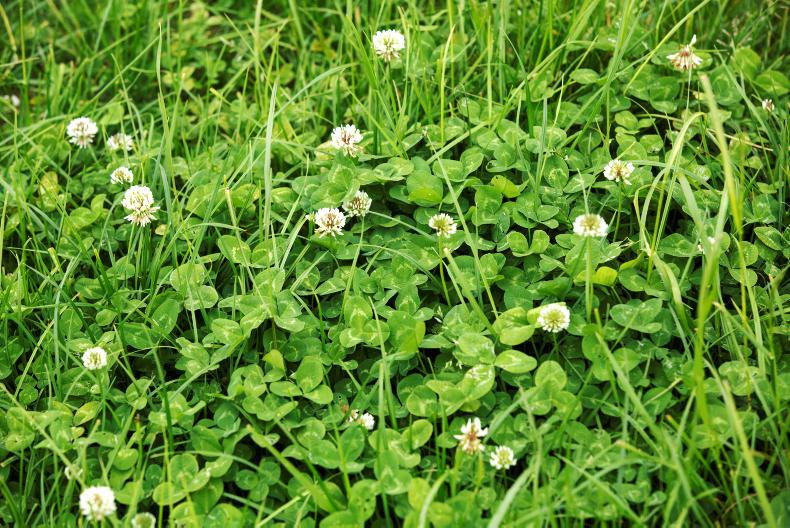In the fourth week of our BETTER Farm challenge review, we take a look into the green farming challenge. The objective of this challenge was to establish more clover in 20% of swards across the whole farm.
Every 1kg of fertiliser N now costs roughly €1, making it quite expensive to artificially fertilise swards. With beef prices in difficulty, any option to cut costs should be of great interest to beef farmers.
Clover has rhizobia bacteria in its roots, giving it the ability to fix atmospheric N and make it available for grass growth. Research has shown it has the potential to supply 50kg to 200kg N/ha per year.


As a result, increasing the clover content in grassland can result in increased herbage production, increased herbage quality, higher intakes and greater animal performance, while at the same time reducing the level of chemical N applied.
Tips for successfully establishing clover
The cheapest way to introduce white clover on your farm is to over-sow (broadcast) it on existing grassland using a fertiliser spreader, slug pellet applicator or similar machine during late spring or after an early cut of silage. Follow these simple steps for best results:
Get a soil test. Soil P and K index of 3 and a pH of 6.0 to 6.8. Clover is not tolerant of low pH. Get weeds such as docks under control before introducing clover. Herbicides that don’t kill clover are usually quite expensive. Seed-to-soil contact and high soil moisture are essential. Ideal conditions are an open sward (eg after first-cut silage), a soil temperature above 8C and where soil moisture is likely to remain high for the next four to six weeks.Over-sow at a rate of 5kg/ha. This can be achieved with a fertiliser spreader by mixing the seed with a zero-N fertiliser (for example 0:7:30). The seed and fertiliser will separate in the spreader during motion and should therefore be mixed regularly during spreading.Apply slurry or a chemical fertiliser containing no N (0:7:30) at sowing.Spread no-N fertiliser for the remainder of the year. This may result in lower herbage production from this area during the year of sowing, but is essential for the establishment of the clover. 
Graze the sward tight and late into the autumn, and graze again in early spring. Try graze at lower covers of 8cm (1,000kg DM/ha). Reseeding is a more expensive option, but might be recommended to establish more productive perennial ryegrasses on old grassland. The above principles for over-sowing clover also apply to establishing clover in a reseed.
In the fourth week of our BETTER Farm challenge review, we take a look into the green farming challenge. The objective of this challenge was to establish more clover in 20% of swards across the whole farm.
Every 1kg of fertiliser N now costs roughly €1, making it quite expensive to artificially fertilise swards. With beef prices in difficulty, any option to cut costs should be of great interest to beef farmers.
Clover has rhizobia bacteria in its roots, giving it the ability to fix atmospheric N and make it available for grass growth. Research has shown it has the potential to supply 50kg to 200kg N/ha per year.


As a result, increasing the clover content in grassland can result in increased herbage production, increased herbage quality, higher intakes and greater animal performance, while at the same time reducing the level of chemical N applied.
Tips for successfully establishing clover
The cheapest way to introduce white clover on your farm is to over-sow (broadcast) it on existing grassland using a fertiliser spreader, slug pellet applicator or similar machine during late spring or after an early cut of silage. Follow these simple steps for best results:
Get a soil test. Soil P and K index of 3 and a pH of 6.0 to 6.8. Clover is not tolerant of low pH. Get weeds such as docks under control before introducing clover. Herbicides that don’t kill clover are usually quite expensive. Seed-to-soil contact and high soil moisture are essential. Ideal conditions are an open sward (eg after first-cut silage), a soil temperature above 8C and where soil moisture is likely to remain high for the next four to six weeks.Over-sow at a rate of 5kg/ha. This can be achieved with a fertiliser spreader by mixing the seed with a zero-N fertiliser (for example 0:7:30). The seed and fertiliser will separate in the spreader during motion and should therefore be mixed regularly during spreading.Apply slurry or a chemical fertiliser containing no N (0:7:30) at sowing.Spread no-N fertiliser for the remainder of the year. This may result in lower herbage production from this area during the year of sowing, but is essential for the establishment of the clover. 
Graze the sward tight and late into the autumn, and graze again in early spring. Try graze at lower covers of 8cm (1,000kg DM/ha). Reseeding is a more expensive option, but might be recommended to establish more productive perennial ryegrasses on old grassland. The above principles for over-sowing clover also apply to establishing clover in a reseed.









 This is a subscriber-only article
This is a subscriber-only article













SHARING OPTIONS: